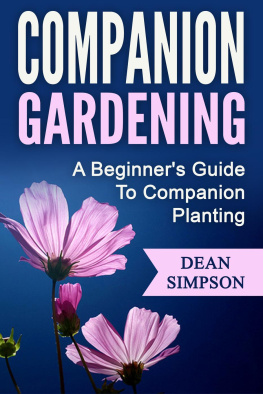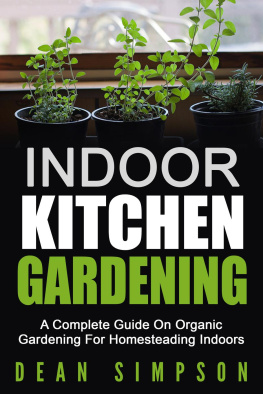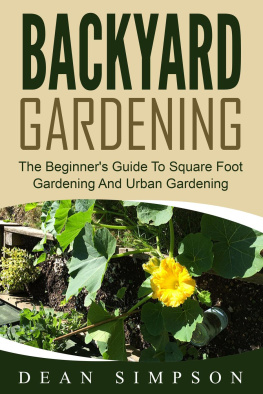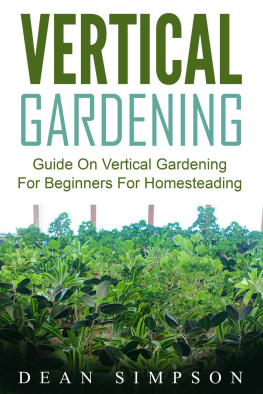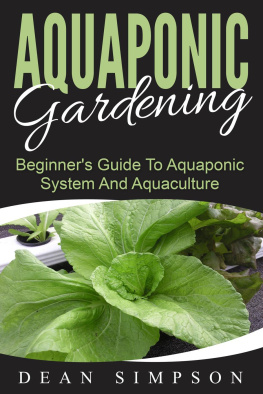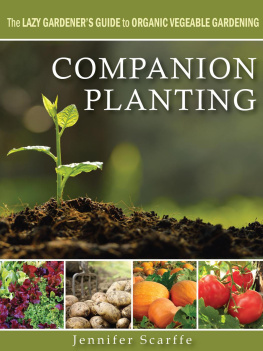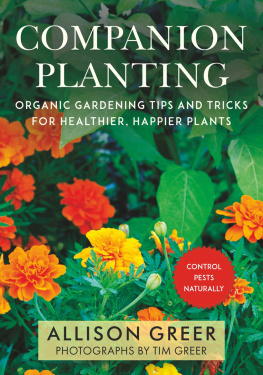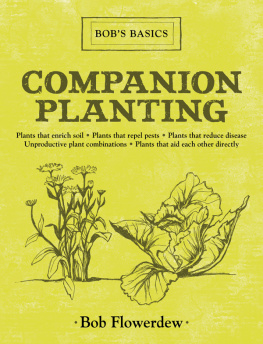Dean Simpson - Companion Gardening: A Beginners Guide To Companion Planting
Here you can read online Dean Simpson - Companion Gardening: A Beginners Guide To Companion Planting full text of the book (entire story) in english for free. Download pdf and epub, get meaning, cover and reviews about this ebook. year: 2017, publisher: Dean Simpson, genre: Children. Description of the work, (preface) as well as reviews are available. Best literature library LitArk.com created for fans of good reading and offers a wide selection of genres:
Romance novel
Science fiction
Adventure
Detective
Science
History
Home and family
Prose
Art
Politics
Computer
Non-fiction
Religion
Business
Children
Humor
Choose a favorite category and find really read worthwhile books. Enjoy immersion in the world of imagination, feel the emotions of the characters or learn something new for yourself, make an fascinating discovery.
- Book:Companion Gardening: A Beginners Guide To Companion Planting
- Author:
- Publisher:Dean Simpson
- Genre:
- Year:2017
- Rating:4 / 5
- Favourites:Add to favourites
- Your mark:
- 80
- 1
- 2
- 3
- 4
- 5
Companion Gardening: A Beginners Guide To Companion Planting: summary, description and annotation
We offer to read an annotation, description, summary or preface (depends on what the author of the book "Companion Gardening: A Beginners Guide To Companion Planting" wrote himself). If you haven't found the necessary information about the book — write in the comments, we will try to find it.
Dean Simpson: author's other books
Who wrote Companion Gardening: A Beginners Guide To Companion Planting? Find out the surname, the name of the author of the book and a list of all author's works by series.
Companion Gardening: A Beginners Guide To Companion Planting — read online for free the complete book (whole text) full work
Below is the text of the book, divided by pages. System saving the place of the last page read, allows you to conveniently read the book "Companion Gardening: A Beginners Guide To Companion Planting" online for free, without having to search again every time where you left off. Put a bookmark, and you can go to the page where you finished reading at any time.
Font size:
Interval:
Bookmark:
While every precaution has been taken in the preparation of this book, the publisher assumes no responsibility for errors or omissions, or for damages resulting from the use of the information contained herein.
COMPANION GARDENING: A BEGINNER'S GUIDE TO COMPANION PLANTING
First edition. March 14, 2017.
Copyright 2017 Dean Simpson.
Written by Dean Simpson.
10 9 8 7 6 5 4 3 2 1
Companion Planting Guide
I fyou wish to get the most out of your gardening/farming output, you have to put in place a technique known as companion planting.
Companion planting refers to planting two or more plants next to one another, which will motivate each other to thrive and grow at an elevated pace,which will result in a better output for you.
But how does one know which plants fare well next to each other, and which ones will not?
Thats exactly where this book steps in! This book will serve as your companion planting guide and give you an idea of what the concept deals with.
We will look at the different plants that can very well accompany some of your standard garden plants, and also run you through its importance.
Lets get started!
F irst and foremost, I thank you for choosing this book and hope you have a good time reading it.
In this first chapter, we will look at the importance of having companion plants in your garden.
T he first and most obvious use is better yield. You will have the chance at getting a better yield out of your gardening input as your plants will strive and try to outdo each other. You will have more fruits, vegetables, herbs etc. After all, isnt that the primary focus of any gardener? To make the most of their produce, and if companion planting will aid in the process then there is all the more reason for you to indulge in the same!
R emember that companion planting also includes avoiding planting those plants that will not work well with the existing ones. With the use of companion planting you can promote healthier plants. When plants get to spend time with neighbors that they will love and appreciate, it is obvious that they will do well. They will start growing stronger stems, branches, brighter flowers, healthier fruits etc. All of this will benefit you as a gardener.
Y ou can save many resources by choosing to indulge in companion planting. Right from water to fertilizers, you can save on many resources and ultimately save on money as well. Saving resources can also mean caring for the environment. You will contribute towards conserving water which is a scarce resource.
Y ou can also prevent pests from entering your garden and ruining the atmosphere. Right from aphids to mealy bugs, you can prevent these pesky pests from ruining your crops. By placing a few insect repellent plants next to the ones that attract them, you can successfully put an end to the menace. Plants that have a strong smell will successfully repel all the insects. So aromatic plants such as basil, rosemary, thyme and marigolds can all be planted around your plants to prevent them from inviting unwanted insects!
A t the same time, you can also attract good insects into your garden. These good insects will promote healthier plant growth and make it conducive for your plants to thrive. Good insects are also helpful for keeping the bad ones out of your garden. These include ladybird bugs, praying mantis and wasps. These eat the bad insects and aid in keeping your garden healthy.
B y indulging in companion gardening, you can diversify the plant variety in your garden. You need not grow the same plants over and over again and introduce several different ones. The diversity in your garden can also help you gain knowledge. You will know to prepare the garden to grow a diverse range of vegetables, fruits and herbs.
I ncorporating companion plants will also help you maintain soil health. You dont have to worry about too much erosion as crop rotation will take place in your garden. This is also great for the environment as you will contribute towards conserving it. You can maintain a healthy garden where healthy plants will produce amazing produce year after year!
These form some of the uses of companion planting but it is not limited to just these. You will be acquainted with the rest as and when you start indulging in the practice.
I n the previous chapter, we looked at all the benefits of indulging in companion planting and in this one; we will look at which plants can be planted next to your vegetable plants to help them thrive.
C abbage is a very common vegetable that is grown in the garden. It is highly susceptible to pests and so, you have to plant insect repellant plants next to it.
Compatible: Tomatoes, Brussel sprouts, spinach, celery. These plants will help repel the worms that the cabbage attracts. Try planting tomatoes all around cabbages so that you can prevent any infestation from occurring.
Incompatible: Cabbages and strawberries will not work well together. Both will attract the same type of worms, which can colonize over a period of time.
B eans are great plants to grow in the garden and will almost always produce a great yield. However, they are prone to tiny worms which eat away into the center of the vegetables.
Compatible: Plant these close to beans, cabbage, carrots, cauliflower, corn and marigolds. All of these plants will do a great job at repelling the insects, especially the marigold. They will also make for extremely compatible plants that will encourage beans to grow efficiently.
Incompatible: Fennel, garlic, onions and leeks will not do well with beans. They will end up competing with beans and prevent its proper growth.
T omatoes are plants that will mostly get along with any other plants. However, you have to plant the ones that will prevent a mealy bug infestation.
Compatible: Carrots, cabbage, potatoes, leeks, onions, peas. These are great companions for your tomato plants, especially carrots, which will encourage tomatoes to grow bigger and better. It will also result in carrots that can be harvested early.
Incompatible: Keep these away from cabbage, fennel and potatoes as they will suck away the nutrition meant for your tomato plants.
P otatoes are great vegetables to pick for your outdoor garden. They can yield a large batch just with a small input. You dont have to find seed potatoes and just cutting a few healthy ones will help you remain with a large batch within a couple of months. However, they require a lot of water and so you have to plant other plants that will not need as much.
Compatible: Beans, cabbage, horseradish and marigolds are all great options to be placed next to potato plants. Although some of these will require a little more water than the others, they will help potato plants remain with a sufficient amount.
Incompatible: Tomato, sunflowers and cucumbers will not do well next to potatoes. These require lots of water and will end up crowding the space around the tomato plants.
R adish plants are low maintenance and you can grow them with ease. The best part about these plants is that they will leave you with two vegetables at the end as the leaves and stems are all edible.
Compatible: Peas, lettuce and cucumber will do very well with these plants. They will not compete with radish and protect it from aphids, squash bugs and white flies.
Font size:
Interval:
Bookmark:
Similar books «Companion Gardening: A Beginners Guide To Companion Planting»
Look at similar books to Companion Gardening: A Beginners Guide To Companion Planting. We have selected literature similar in name and meaning in the hope of providing readers with more options to find new, interesting, not yet read works.
Discussion, reviews of the book Companion Gardening: A Beginners Guide To Companion Planting and just readers' own opinions. Leave your comments, write what you think about the work, its meaning or the main characters. Specify what exactly you liked and what you didn't like, and why you think so.

